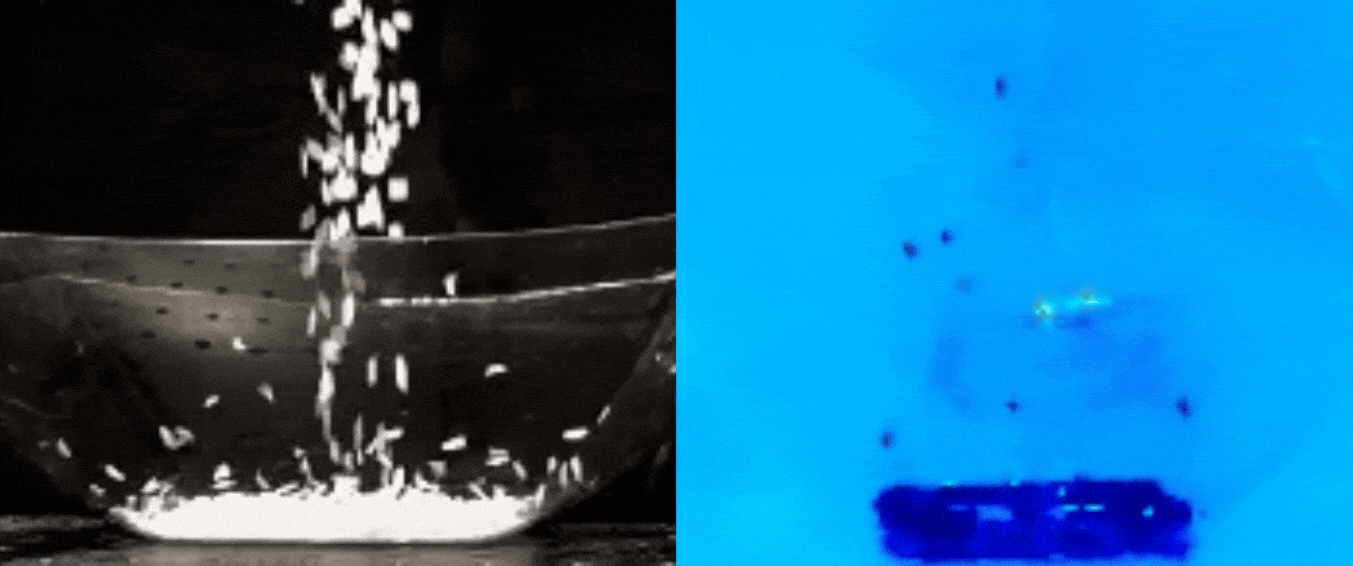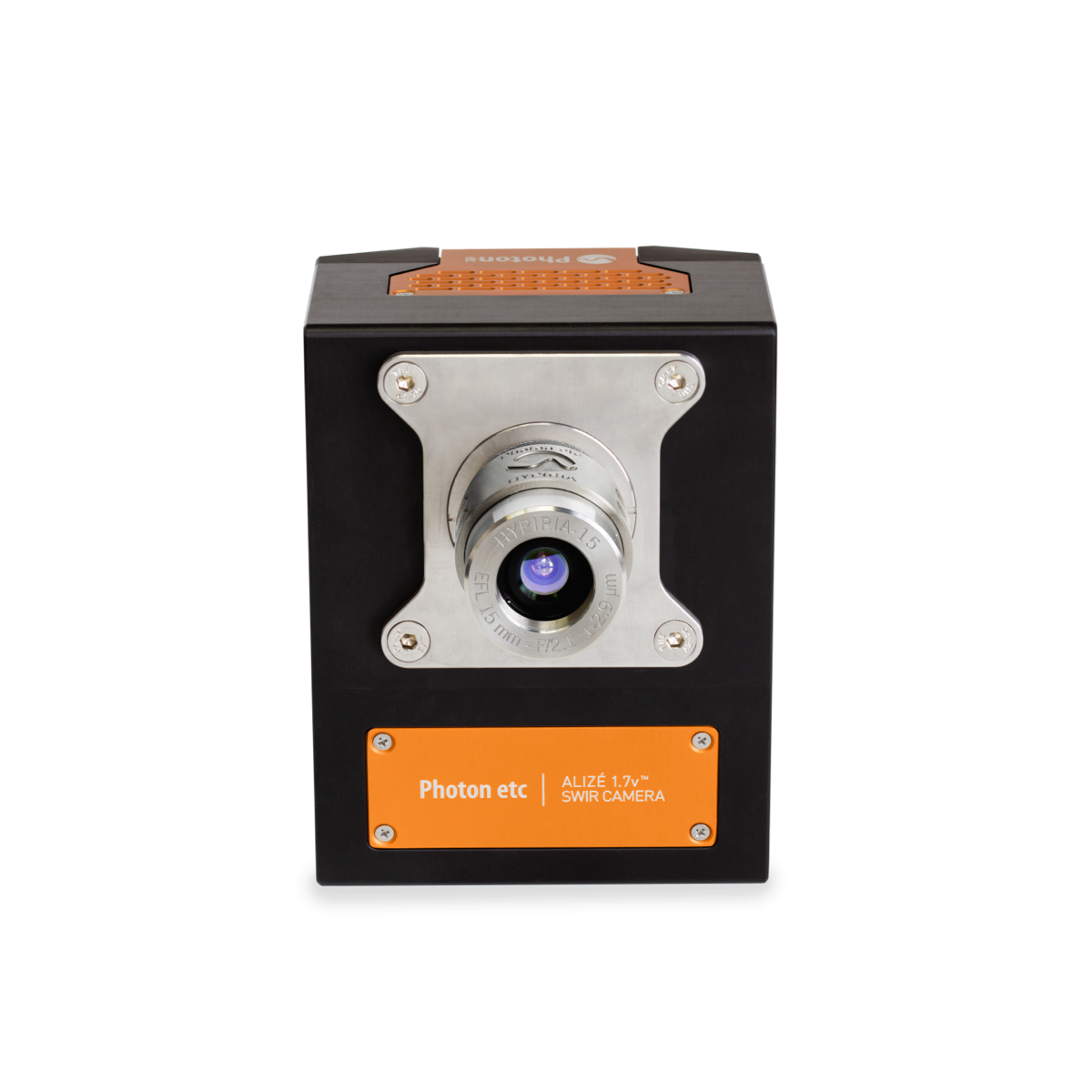NIR imaging with this versatile InGaAs camera
The Alizé 1.7 is a high-end, scientific grade, 640 x 512 pixels resolution, InGaAs camera that marries performance with reliability. It has low noise levels, high efficiency, and a rapid frame rate compatible with an external trigger. This is made possible by a combination of state-of-the-art control electronics and a four stage thermoelectric cooler (TE) which can maintain an operating temperature as low as -60 °C. The cooler uses forced air cooling which requires none of the maintenance of a water or liquid nitrogen cooled unit.
The Alizé 1.7 is amongst the most cost-effective high-end InGaAs cameras on the market.

Photon etc. InGaAs cameras are able to easily detect fake (neon green) rice among a continuous stream of real rice (dark blue), an innovation that opens the door to fast real-time food contaminant detection.
Alizé 1.7 Applications Overview
NIR-II/SWIR Bio-imaging
Photovoltaics characterization by photoluminescence (PL) and electroluminescence (EL) using SWIR imaging
Semiconductor wafers inspection and device failure detection
Laser beam profiling
Product Specifications
| Alizé 1.7x | Alizé 1.7s | |
|---|---|---|
| Sensor | InGaAs FPA | InGaAs FPA |
| Sensor Format | 640 x 512 | 640 x 512 |
| Pixel size | 15 µm | 15 µm |
| Spectral range | 500 - 1700 nm | 900 - 1700 nm |
| Peak Quantum Efficiency | > 85 % | > 80 % |
| Typical operability | > 99.9 % | > 99.5 % |
| Cooling Temperature @ 20°C ambiant | -60 °C | -60 °C |
| Cooling method | TEC + forced air | TEC + forced air |
| Typical Dark Current* | 150 ē/px/s | 240 ē/px/s |
| Typical Gain setting (ē/ADU) | High: 2.67 | Low: 47.5 | High: 2.2 | Med: 7.4 | Low: 89 |
| Typical readout noise (ē) | High: 22 | Low: 135 | High: 35 | Med: 75 | Low: 315 |
| Frame rate in CameraLink™ (fps) | High: 105 | Low: 210 | Up to 240 full frame. 1900 for a 128x128 ROI |
| Frame rate in USB 3.0 (fps) | High: 110 | Low: 220 | Up to 250 full frame. 1900 for a 128x128 ROI |
| Integration time range | from 1 μs to full well capacity | from 1 μs to full well capacity |
| Digitization (bits) | 13 | 14 |
| Image Format | 16 bits HDF5, FITS and TIFF | 16 bits HDF5, FITS and TIFF |
| Software | PHySpec™ control and analysis software, SDK (C++, Python) | PHySpec™ control and analysis software, SDK (C++, Python) |
| Computer interface | USB 3.0 and CameraLink™ | USB 3.0 and CameraLink™ |
| Ambient temperature range | 10 °C to 35 °C | 10 °C to 35 °C |
| Power Supply | 12V DC | 12V DC |
| Dimensions | 169 mm x 130 mm x 97 mm | 169 mm x 130 mm x 97 mm |
| Weight | 2.9 kg | 2.9 kg |
Spec Sheet
Videos
When Art, Science and Technology Work Hand in Hand
Photon etc. presents this short film shot in collaboration with Dr. Daniel Heller, researcher at the Memorial Sloan Kettering Cancer Center and Joseph Cohen, multidisciplinary artist. This short video documents how three experts in their respective fields benefit from and are enhanced by their mutual collaboration. Joseph creates new paint mixtures and textures using carbon nanotubes (CNT). Dr. Heller develops infrared probes and biomarkers using CNT’s. Sébastien (CEO at Photon etc.) develops science grade infrared cameras that can detect fluorescent CNT’s excited by specific wavelengths.
In Vivo NIR-II Imaging: Contact-Free Monitoring Heartbeat & Respiratory Rate
High-speed imaging made available by the fast frame rates of InGaAs cameras allows for contact-free cardiography and respiratory rate measurements in both anesthetized and awake animals. Such contact-free measurements of awake mice obtained without the use of any restraining device could drastically change studies procedures in labs.
Real-Time Biodistribution and Pharmacokinetics of ICG in a Mouse Using NIR-II Fluorescence
Video of IR VIVO imaging experiment showing the biodistribution and pharmacokinetics of ICG in real time. IR VIVO is able to visualize NIR probes at high resolutions. From one single injection, it was possible to obtain measurements of heartbeats, respiration and intestinal contraction rates.
In Vivo NIR-II Imaging of Liver Metabolism, Hepatobiliary Elimination & Gastro-Intestinal Motility
With a simple tail-vein injection of ICG, we can study liver metabolism, measure hepatobiliary elimination and monitor gastrointestinal motility simultaneously in vivo and contact-free. Such a straightforward method to image the intestine could help research on metabolic diseases.
White Papers
Cooling SWIR Sensors: an Overview
Authors Marie-Christine Ferland and Laura-Isabelle Dion-Bertrand
